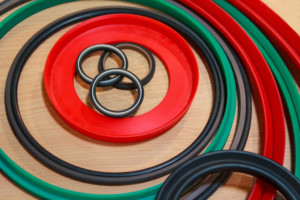
If you plan to order custom rubber components for the first time, then you should learn about two of the most common processes used to shape rubber: rubber injection molding and rubber extrusion. While both rubber part manufacturing techniques are used to create a wide variety of rubber shapes and products, each rubber shaping process has its unique advantages and disadvantages.
Read on to learn more about rubber injection molding and rubber extrusion, including how each rubber-shaping method works and the unique advantages of each technique.
Rubber Injection Molding
Injection molding is one of the most common rubber molding techniques used today.
How This Process Works
All injection molding projects start with the creation of a custom rubber mold designed in the exact shape and size of the desired final rubber part. After this mold is fabricated, it is then placed in a rubber injection molding machine.
Next, uncured rubber is fed into the machine through a special screw feeder. The rubber then travels to a barrel where it is heated just enough for a plunger to push it into a second chamber. There, the rubber is further heated and then injected at high pressure into the rubber mold where it is then allowed to cure. After the rubber has completely solidified, the rubber parts are removed from the molds.
The rubber injection molding shaping process is often use to create rubber parts such as seals and gaskets, check valves, backflow preventers.
Injection Molding Advantages
This rubber molding process offers many unique advantages that are difficult to obtain with other rubber shaping techniques. First, many rubber components can be created very quickly with injection molding. This speed is beneficial when large orders for rubber components need to be fulfilled in a short period of time. In addition, this rubber-shaping technique is precise and accurate, with little risk of producing bad parts that cannot be used.
Rubber Extrusion
Rubber extrusion is another popular rubber product manufacturing process.
How This Process Works
Before custom rubber parts are created with the extrusion process, a custom die must be created instead of a custom mold. The extrusion process begins by equipping a rubber extrusion machine with this die and then feeding a rubber compound into the machine hopper.
A heated shearing screw then moves the rubber along a conveyor where the substance gradually heats and softens as it moves through the machine. Finally, the extrusion machine forces the softened rubber through the die to form it into the desired component shape.
One or more secondary operations can be performed on your rubber parts to further customize them after they exit the extrusion machine. Just a few of these secondary operations include:
- Drilling: Holes can be drilled into extruded rubber parts when necessary.
- Flocking: This process involves adhering fine polyester or nylon fibers onto the rubber part to reduce surface friction.
- Splicing: Many splicing methods can be used to join two or more extruded rubber parts together.
- Urethane slip-coating: A low-friction, urethane slip coating can be applied to rubber part exteriors to improve abrasion resistance.
Ask your rubber manufacturing expert about any additional secondary operations your rubber components may require after extrusion.
Extrusion Advantages
The rubber extrusion process also has unique benefits. This process is typically the best option when producing long rubber parts, such as rubber hoses, weatherstripping, and various types of tubing.
However, this versatile process can also be used to create small rubber items, such as gaskets and connectors. Finally, the rubber extrusion produces little waste, which helps keep production costs low.
Rubber injection molding and rubber extrusion are two popular rubber part manufacturing processes, and each of these rubber shaping techniques has its benefits. Contact the expert rubber products manufacturers at Accurate Products for all of your custom rubber product needs today.